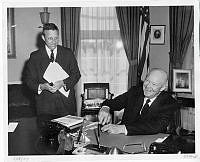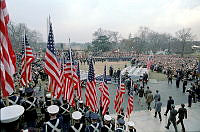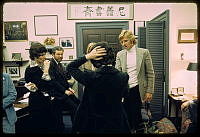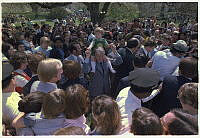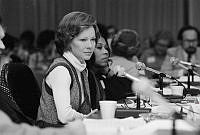Livery at the White House
The Failed Plan to Establish a Whiff of Monarchy
Copyright © Fall 2012 White House Historical Association. All rights reserved under international copyright conventions. No part of this article may be reproduced or utilized in any form or by any means, electronic or mechanical, including photocopying, recording, or by any information storage and retrieval system, without permission in writing from the publisher. Requests for reprint permissions should be addressed to books@whha.org

Britain’s Puck magazine featured this cover on the September 26, 1906 issue, three years after the Theodore Roosevelt administration introduced a controversial new usher’s uniform. It reflects what became a lasting public perception that an ostentatious Theodore Roosevelt administration had done away with the republican simplicity at the White House.
On Saturday, October 24, 1903, the sensationalist New York World reported that President Theodore Roosevelt’s secretary, William Loeb Jr., outfitted the messengers at the White House in “uniforms of dark blue material with shining nickel buttons.” The World also noted that “it is Mr. Loeb’s intention to put all the employees around the White House and executive offices in uniforms.”1 For Roosevelt and Loeb, such an innovation seemed practical and necessary for the modern presidency as it identified the mansion’s messengers delivering the president’s notes and messages to cabinet officers and members of Congress. Yet the seemingly innocuous plan challenged the principle of republican simplicity that had guided the sartorial choices of presidents and their staff since the presidency of George Washington. Even worse, the uniform plan also threatened to move the White House toward the symbols of monarchy. As the World told its readers, “The uniforms planned for the ushers at the White House are gorgeous and will remind travelled visitors of the courts of Europe.”2
Within days of the World’s front-page article on the “gorgeous uniforms” of the White House, other newspapers satirized the plan in a play, political cartoons, and editorials. New York newspapers found it easy to politicize Roosevelt and Loeb’s decision to uniform White House messengers, doorkeepers, and policemen in the context of an important mayoral election then being held in New York City. More important, the media’s debate demonstrates that no matter the nation’s recent rise to world power, the cherished principle of republican simplicity was still vibrant—especially among rural Americans—even as both the presidency and the White House were undergoing major symbolic changes during Roosevelt’s administration.
American sentiment against aping the airs of monarchy had its origins in the principles of the American Revolution. The nation had shed its relationship with a monarchical system, and any attempt to mimic that system contradicted the meaning of the Revolution. This idea applied to formal or official dress of all public servants from president to diplomat to congressman. Yet presidents celebrated the presidency on a fine line, mixing republican simplicity and the pomp and circumstance commonly associated with monarchies. To help define the status and formality of the presidency, presidents since the administration of George Washington adopted a livery for their footmen and coachmen to help identify them as part of the president’s household. The first president’s coachmen wore white and orange. President Thomas Jefferson scoffed at Washington’s monarchical pretensions, but he, too, installed a livery for his coachmen, which consisted of blue coats accented by crimson and edged with lace. President Ulysses S. Grant dressed his footman and coachman in a dark blue uniform with silver buttons.3
The upper White House staff was occasionally uniformed as well. In a departure from most of his predecessors, President Chester A. Arthur sharpened up the appearance of his White House staff by outfitting his coachmen and footmen in fine livery and the doormen in black suits, with ribbons pinned to their lapels for further identification. Servants in Arthur’s household wore livery of dark blue. Similarly, in the summer of 1897, President William McKinley’s private secretary, John Addison Porter, placed the inveterate White House doorkeeper Arthur Simmons in a uniform of “dark blue with white narrow stripes.” By the fall of 1897, the other White House office employees and messengers donned similar uniforms to help visitors “distinguish between those in authority and mere spectators.” Porter’s uniform plan, however, “was ridiculed as savoring of aristocratic institutions” and quickly discarded.4

The New York World, October 27, 1903, presented a pageant of supposed livery worn in Theodore Roosevelt’s White House. By portraying the White House employees in this manner, the cartoon presents the uniforms not as an innovation needed for the modern presidency but as products of an outmoded era that Americans had already escaped through republican revolution.
When Theodore Roosevelt ascended to the presidency in September 1901 following the assassination of McKinley, he sought to redefine the image and symbolism of the presidency as well as to illustrate the greater power of the office, achieved by McKinley in the Spanish-American War, 1898. The White House, its environs, and the mansion’s employees were an important tool in achieving this goal. Less than a month after taking office, Roosevelt and his wife Edith instituted a new livery for the coachman and footmen based on livery traditionally used by the Roosevelt family.
According to the technical journal American Tailor and Cutter, the uniform was designed by Edith Roosevelt and consisted of blue coat and trousers. Both garments were cut in the “military” fashion with a “snug waist and broad square shoulders.” Both the coat and trousers were made from vicuña wool, the most luxurious and expensive material available at the time. Similar to the uniforms designed by Porter in McKinley’s administration, the uniforms featured outer seams of the trousers “bound with a white cord.” Coachmen and footmen alike sported a hat with a cockade of red, white, and blue. A little more than one year later, the Roosevelts scrapped the blue trousers in favor of a more fashionable style. Roosevelt retained the blue-colored coat for the coachmen and footmen but placed them in “tight-fitting” doeskin breeches. The “high hat” with a “red, white, and blue cockade” remained an important feature: “High patent leather boots,” the New York Times reported, “complete the outfit.” The new uniforms were also accompanied by two of the “finest” carriages, horse blankets, and carriage covers.5
Clothing protocol for those stationed inside the White House during Roosevelt’s presidency remained unchanged, however, even as new uniforms were assigned to the stable staff and the White House was renovated at the cost of $500,000. A major player in the decision was George B. Cortelyou, secretary to the president. Cortelyou had been appointed as Grover Cleveland’s stenographer in 1895. Upon leaving office, Cleveland recommended the young stenographer to McKinley, who appointed him executive clerk and later as his assistant secretary. In 1899, Cortelyou replaced an ailing Porter as secretary to the president.
Fully aware of the political fallout of Porter’s uniform scheme, Cortelyou always took into account the importance to the public of maintaining the republican image of the presidency. Cortelyou thus ensured that those who protected the president—Post Office inspectors and Secret Service operatives—wore plain clothes as they always had. The Washington, D.C., Metropolitan Police officers who guarded the White House, however, wore plain fatigue uniforms inside the mansion, while those stationed outside the walls of the mansion wore regular uniforms. The symbols of rank of the officers were sewn to the left cuff of their uniform, but badges or other signs of authority were not to be displayed. Additionally, in a pamphlet entitled “Special Instructions to the Chief Doorkeeper and Those Under His Immediate Supervision,” Cortelyou outlined specific clothing protocols for—among other things—the White House doorkeepers. They were to always present a “neat appearance, with smooth parts of the face clean shaven, shoes blacked, clothes brushed, linen clean.” Cortelyou also specified that they were to wear suits “dark in color.”6
Cortelyou’s successor, William Loeb, aroused more controversy over livery than any of his predecessors. He was a forceful, abrupt official who, in this case, disregarded the fundamental republican tenet of the American presidency. Born on October 9, 1866, in Albany, New York, Loeb, as one newspaper aptly put it, “made his own way in the world.” From a messenger boy for the Albany Telephone Company he rose through perseverance to stenographer, at which he was expert, and in 1888 the New York State Assembly elected him the official stenographer. By then heavily involved in the state’s Republican Party, Loeb was chosen as part-time stenographer by New York Governor Levi P. Morton and in 1899 was hired full-time by the newly elected Governor Theodore Roosevelt. Loeb followed Roosevelt to the vice president’s office, and after McKinley’s assassination, Roosevelt appointed the dutiful Loeb as assistant secretary to the president, from which he rose to secretary in February 1903, upon George Cortelyou’s appointment as the first secretary of commerce. Loeb often advised the president and proved indispensable. He skillfully managed the press and was a buffer for the president. The New York Times later reported, Loeb stoically received his “lashings and the brickbrattings” from the press. The uniform controversy was not an exception.7
Several of the nation’s newspapers reprinted the New York World’s story on the uniform scheme, maintaining the general structure and substance of the story but adding sharp editorial commentary, including pointed references to the “shiny, nickel buttons.” While insignificant to the modern observer, for contemporaries the reference to nickel implied the expense of the uniforms, for, excluding silver and gold, nickel was more expensive than any other metal at the time and was in high demand for industrial and military applications. Some of the most pointed comments on the uniforms emanated from the South and Middle West, demonstrating the high value rural parts of the country placed on republican simplicity. The Decatur Daily Review, in the heart of rural Illinois, maintained that the White House resembled “foreign courts,” with “buttons, lace, and kowtows” installed by Roosevelt and Loeb. “The President’s secretary Mr. Loeb,” the Richmond (Va.) Times Dispatch reported, “is responsible for the change, but Mr. Roosevelt is going to catch the blame from those Americans who do not like to see the White House people aping the doings of foreign courts.”8
Several newspapers, however, defended the decision to outfit the White House staff in uniforms as a simple necessity. “There is a tendency to criticize the innovation of requiring the attendants at the White House to wear uniforms,” a correspondent for the New York Times editorialized. While Americans held a “general antipathy to anything like the flunkeyism characteristic of European Courts,” the aim of the plan “is to distinguish the attendants so that strangers who go to the Executive Mansion may know whom to address for information or guidance.” Even the New York Sun—no friend of the Roosevelt administration—came to the president and Loeb’s defense. “No one will feel more grateful for the new uniforms to be worn by the White House attachés,” the Sun correspondent wrote, “than those who will attend the official and private functions there this winter.” The correspondent noted that “full evening dress was adopted” by the president’s staff during “evening receptions, musicales, and other entertainments” and “no matter how much a guest wished to address an attaché of the house, he dared not approach one of the ushers for fear of making a mistake and insulting one of the president’s guests.” Such embarrassing situations, explained the Sun, made Loeb, the president, and the first lady devise the uniform plan in accordance with America’s republicanism. “Great fear was expressed by the president that the mistake of giving the men the appearance of flunkies might be made,” according to the Sun, and “after the greatest possible thought” the Roosevelts selected plain blue uniforms. “Everyone is wondering why the change was not made before,” the Sun concluded.9

The Minneapolis Journal, on October 26, 1903, labeled White House servants as “just plain Americans” and portrayed them dressed as Uncle Sam by direction of Theodore Roosevelt. Ironically, the servants look even more American beside two carefully groomed European guests.
The Minneapolis Journal reinforced the words of the New York Sun by publishing a witty cartoon on October 26, 1903. The cartoon was drawn by Charles Lewis Bartholomew, who was more commonly known under the pseudonym of “Bart.” In the cartoon, Bartholomew labeled the servants as “just plain Americans” and portrayed them in Uncle Sam uniforms attending to two guests. Moreover, the servants look even more American when compared to their European guests in the cartoon, whose hair is waxed, their facial hair stylized, and one of whom is wearing a monocle. In a perverse way, the cartoon also reinforces the rationale for the uniforms, setting the servants apart from the guests so that “Mrs. Smith Brown will not be embarrassed by asking the Boolgarian [sic] minister to bring her a glass of water.”10
Despite such support of the uniforms, the plan was abandoned by the White House only three days after being implemented. The exact impetus for ditching the plan is unknown, but several papers noted that the president and Loeb received letters condemning the scheme. “The president has been hearing from the people,” the Philadelphia Recorder reported, “and is more than ever convinced that this is a republic.” Similarly, the Logansport (Ind.) Journal noted that the plan “excited so much adverse comment that the president decided to have it abandoned.” The New York Times also reported Roosevelt received letters that had “much to say about the enormity of having ‘flunkies’ at the very center and culmination of our democratic institutions.” The editorialist for the New York Times labeled any criticism “silly” and regretted the plan’s abandonment. “A uniform,” the Times argued, “when properly designed for a proper end, is an excellent thing, bestowing many and practical advantages such as no self-respecting man need hesitate to use or give.” The Times continued, “We cannot believe that the President refrained from uniforming the White House staff for fear of betraying aristocratic or monarchical tendencies.” Nevertheless, it was, as the Boston Globe penetratingly noted, a “veto on flunkeyism.”11
The New York World kept the uniform controversy in the face of its readers, hoping to influence two important impending elections—the 1903 New York City mayoral contest and the 1904 presidential election. Indeed, the owner Joseph Pulitzer did not care about the outcome of the mayoral race, but many Americans interpreted the 1903 New York City mayoral election as a litmus test for the 1904 presidential race. As Roosevelt told the incumbent New York City mayor, Seth Low, the Democrats “wished to win this year so as to better their position in the Presidential contest next year.” Furthermore, many New York City Republicans bolted their party in favor of the Democratic Party candidate, U.S. representative, and son of the Union general of the same name, George B. McClellan Jr. This switch was seen as “treachery” by Roosevelt, but others viewed it as a sign that the president’s political power was at its nadir, especially in his home state.12
The stark reality was that Roosevelt and the World’s chief shared mutual hatred. Since Roosevelt’s tenure in the New York State Assembly from 1882 to 1884, the pro-Democratic World frequently attacked Roosevelt in its editorial pages. This criticism subsided after Roosevelt was elected governor of New York in 1899 because, as Pulitzer’s biographer James McGrath Morris noted, the publisher’s interest in politics had significantly “diminished” in favor of remodeling his home and establishing a school of journalism at Columbia College (today Columbia University). The looming party conventions and presidential election of 1904, however, rekindled Pulitzer’s love of politics. Correspondingly, beginning in late 1903, the World’s editorials in regard to Roosevelt and his associates became more venomous. As far as the uniform scheme was concerned, the World’s continued criticism was not only a veiled political assault by Pulitzer but also the beginning of a sustained barrage of editorials and cartoons made against the Roosevelt administration.13
The World printed a scathing criticism of the uniform plan in the October 27, 1903, evening edition, which, incidentally, happened to fall on the president’s forty-fifth birthday. The World prominently featured a cartoon and play titled “The Wicked Loeb and the Disillusioned Roosevelt; or, the Abandoned Plot to Put the White House Staff in Livery.” The political cartoon had been, since its introduction by Pulitzer in 1884, the World’s most effective editorial weapon.14 The cartoon portrays nine executive branch employees whose garish costumes are bizarre reflections of an imagined European court, a comical flavoring of Tudor England.
If people were not amused by the cartoon, they could read the play by Samuel G. Blythe below the cartoon. The 32-year-old Blythe was hired in 1900 to run the World’s Washington bureau.15 His short play in three acts portrays the president and Loeb as blithering idiots intent on subverting the symbolism of the White House and the presidency. Act I, “The Inspiration,” humorously outlines how Roosevelt and Loeb crafted the uniform plan. “What this administration needs is more color,” says Roosevelt to Loeb, “more beauty, more scenery, so to speak.” Calling Roosevelt “sire,” Loeb suggests that they paint the White House red. Roosevelt likes the idea but thinks it might be best for his second term. Planning to uniform the servants and the staff depending upon their duties, Roosevelt does not wish to stop at the White House. “This idea is too great to be devoted to servants,” he says to Loeb. They extend the plan to the House of Representatives, the Senate, and the cabinet. Roosevelt even designs a uniform for the president, which combines the “striking features of the uniform of the General of the Army and Admiral of the Navy.” Act I closes with an unidentified man suggesting to Roosevelt and Loeb that they design a “striped costume for those Post-Office thieves,” another blatant jab at the Post Office scandal.

The Newark (Ohio) Advocate, a cartoon by an unkown illustrator, November 5, 1903. While the staff uniforms were not as garish as in the World’s cartoon, a similar point is made as Secretary Loeb reviews the White House staff in front of the South Portico, walking briskly, smiling with self satisfaction at his new uniforms, and even saluting.
Acts II and III of Blythe’s play, entitled “The Realization” and “The Culmination,” respectively, reinforce the imagery that Roosevelt was out of touch with America and its love for republican simplicity. Shortly after implementing the uniforms, Loeb and Roosevelt start receiving criticism in the mail. “Is this an empire or a republic?” asks one questioner; and another inquires, “When did you get to be King?” With such criticism, Roosevelt quickly realizes that he “must desist until I am safely in the White House for a full term.” The play ends with a false “official statement” from the White House that announces the abandonment of the uniform plan. Interestingly, it places the entire scheme on the shoulders of Loeb.
The World’s cutting stage comedy and cartoon clearly influenced other newspapers to adopt a more spiteful tone. “Mr. Loeb may be a citizen and native of the United States,” the Bisbee (Az.) Daily Review informed its readers, “but his ideas are far from American.” The Daily Review falsely reported that the servants were outfitted in “old and scarlet coats, and skin tight melon breeches, ramrods stuck down their backs and with snobbish airs like monkeys ape the customs of the slaves, who beck and crawl at the foot of royalty.” The Daily Review also proclaimed that the abandonment of the “silly and asinine proposition of his secretary” represented a victory for the New York World that originally “took up the matter” on behalf of the people of America. “There is enough flunkeyism in the average community now, without carrying it into the White House, which is the house of the nation.” The Lincoln (Neb.) Commoner maintained that “the men in the White House will blaze with all the glory of the flunkies at European courts when the social season opens.” Some newspapers charged that Loeb was neglecting his duties as secretary because of the outlandish uniform scheme. “Secretary Loeb is so busy designing court costumes,” the Marion (Ohio) Sentinel told its readers, “that he has turned the job of officially explaining over to another.”16 The Newark (Ohio) Daily Advocate included its own cartoon of the White House staff in uniforms.17
At first glance, given Roosevelt’s penchant for controversy, it is surprising that the president and his secretary did not react to the negative press. Roosevelt did not even respond to inquiries in this matter made by his friends. On October 25, 1903, the Republican Party luminary and editor of the Chicago Record-Herald Herman H. Kohlsaat sent Roosevelt a handwritten note about the uniform controversy asking, “What have you been doing to our William [Loeb]?” When Roosevelt responded three days later, he politely thanked Kohlsaat for his note and, in typical Roosevelt fashion, made a personal handwritten reference to a dinner at Kohlsaat’s house attended by Alice Roosevelt.18

The journalist Louis A. Coolidge’s “The Uniformed Attendant” (bottom, second column) ran in The Broad Ax (Salt Lake City), among other papers, on November 14, 1903. Coolidge argued that the only unique feature of the uniforms was the buttons of the coats. His article was illustrated by a simple drawing portraying two White House doormen.
Roosevelt did not entirely ignore the issue; he had others speak on his behalf. Journalist and author Louis A. Coolidge a devout Republican, admitted that it was “humorous” to “talk about the aping of royalty,” but he maintained that the uniforms were strictly practical for the modern presidency. They were designed to distinguish the servants from the mansion’s guests at public events, not to elevate the presidency to a monarchy.19 Although the Roosevelt administration abandoned the uniform scheme, the controversy in the fall of 1903 provided the president’s political opponents opportunity to criticize what they viewed as White House extravagance. Such accusations have haunted many presidents. The public’s perception of Roosevelt as a monarch persisted throughout the remainder of his presidency. A 1904 campaign book by Democrat Edward G. Smith argued that Roosevelt was intent on transforming the office of president into that of a monarch. One only needed to look at the “flunkeyism, epaulets, uniforms, liveries, and human dog-collars, clanking of swords, orders of precedence, invitations stamped as regal commands” for confirmation. The reign of “Theodore the Resplendent” needed to end, Smith maintained.20
This image of Roosevelt endured even near the end of his presidency. In 1908, Harper’s Weekly featured an article by David F. Sinclair that was replete with images of a crowned Roosevelt attended by flunkies. Similar to Smith, Sinclair contended the “atmosphere of the White House, once democratic and free, has become tainted with the manners of monarchy.” Moreover, Sinclair argued, Roosevelt’s use of “military display, social censorship, and exclusion of plain people are used to impress the imagination of the unthinking as at the courts of Europe.”21
While Roosevelt and Loeb suffered criticism for the installation of uniforms, elaborate State Dinners, and monarchical protocol, within a few months after taking office, President William H. Taft, Roosevelt’s handpicked successor, adopted the Roosevelt family livery as his own. Moreover, according to Edith Roosevelt’s social secretary Isabella Hagner, the Tafts also placed six ushers at the White House in uniforms of dark blue.22 Successive presidents in the Progressive Era continued to employ uniforms at the mansion. This aspect of Roosevelt’s presidency represents a turning point in the country’s relationship with the president and attendant symbols, such as the White House. Republicanism was giving way to a new perception of the powerful head of state, no longer only the “chief executive,” that would shape the future image of the White House.














